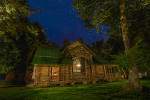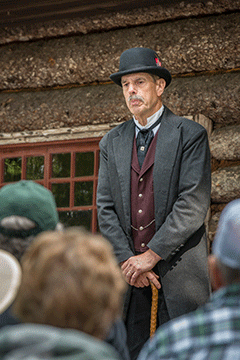History professors revisiting the Gilded Age
02/04/2022

A pair of SUNY Cortland historians have received a $143,000 federal grant to recruit a team of SUNY experts on America’s Gilded Age and Progressive Era in an effort to replace how these pivotal chapters in the nation’s history are understood and taught.
To be clear, they are not replacing current history by tossing it out and inserting something new. They aim to re-“place” the eras, expand the scholarship of the period in the late 19th and early 20th centuries beyond the major cities and timeframe and present it in a wider context.
“Most of the way that that (era) gets told in history textbooks is by looking at cities and what’s happening in urban America, and mostly on the East Coast,” said Randi Storch, a former chair of SUNY Cortland’s History Department and a SUNY Distinguished Teaching Professor.
“Those were important lenses, but maybe they are not the best or only lenses. There is so much scholarship broadening, deepening and expanding the way that historians think about this period of time.”

She and Kevin Sheets, who currently chairs SUNY Cortland’s History Department, are the principal co-investigators on a new two-year study to revise how this American historical period is viewed and taught in schools and colleges, thanks to a $143,000 grant from the National Endowment for the Humanities (NEH).
The professors plan to collaborate with SUNY colleagues to reach as many as 2,000 SUNY students statewide with revised coursework within five years. The NEH special projects grant initiative is called “Re-Placing the Gilded Age and Progressive Era: A SUNY Faculty Study Group Transforms the Teaching and Learning of America’s Pivotal Period.”
“We are ‘replacing’ the Gilded Age/Progressive era with the idea of ‘place,’” Storch said. “Shouldn’t we be thinking about it outside of New York City and the eastern seaboard where it traditionally is thought about, when there were so many other things that were shaping the American experience in this period of time?”
Sheets and Storch are recruiting 20 history scholars at SUNY’s comprehensive colleges. The new network of educators will immerse themselves in the period from the 1870s to the 1920s during a weeklong workshop this summer in a remote Adirondack outpost where Gilded Age and Progressive Era history was likely made: the Huntington Memorial Camp at William H. Parks Family Center for Environmental and Outdoor Education.
SUNY Cortland has owned and carefully preserved the first Great Camp of the Adirondacks, built by industrialist scion William West Durant and later sold to railroad magnate Collis P. Huntington, since 1947. Generations of SUNY Cortland students from majors ranging from physical education to geographic information systems, have benefitted from educational experiences at the center.
Many historians are shifting study of this roughly half century of seismic political, economic and social transformation away from the meatpacking plants of Chicago, the tenements of New York City and the steel mills of Pittsburgh. They’re looking to more rural locales, say, New York state’s Adirondack Park, summer playground of the country’s oil, steel, timber and railroad multi-millionaires.
“To fully understand the story, you need of think about the relationship between different places,” Sheets said. “The obvious example for us to start is our camp. We think of the Adirondacks as a sealed-off wilderness. But New York City has a relationship with the Adirondacks.
“Its water source, the Hudson River, originated in the Adirondacks. The timber that built the buildings of Manhattan, that timber originated in the forests of the Adirondacks. There are relationships between these geographies that are important to understand. If you only focus on the urban story you miss that dynamic interrelationship between those places.”
The study group’s discussions on when and where the Gilded Age and Progressive Era really occurred will be led by two guest scholars, Rebecca Edwards of Vassar College and Kristin Hoganson of University of Illinois at Urbana-Champaign.
Edwards is the author of books on gender and politics in the Gilded Age and on reinterpreting the Gilded Age that are frequently used in colleges and graduate classes.

Hoganson is interested in imperialism and gender and consumption.
“She makes the argument that Americans and American consumers, and particularly female consumers, were consuming a global marketplace of goods,” Sheets said.
In Hoganson’s latest book, The Heartland, she looks at geography and borders and the relationship between different geographies, according to Sheets.
“That’s kind of the heart of what we’re trying to do in the grant: to get people to think about the Gilded Age and Progressive Era as a place, as a moment in time that doesn’t just happen in America’s urban spaces,” Sheets said.
Contemporary historians must look at many different people and examine international developments and transnational movement of people and ideas.
“Their stories help us reframe the way that we are thinking about this period of time,” Storch said. “There are just so many more voices and they’re in so many different places than how historians have traditionally thought about this moment in time.”
After their Adirondack retreat, Sheets and Storch will meet regularly with their SUNY colleagues as they develop new or revised courses and lesson plans to be taught by the 2023-24 academic year. The SUNY Cortland professors will also produce a book that compiles their findings.
Around June 2023, Sheets and Storch will draft the book’s introduction and begin revising authors’ submissions, assisted by SUNY Cortland graduate in history Kaycie Haller ’19, now a Ph.D. candidate at SUNY Albany. The forthcoming manuscript Re-placing the Gilded Age and Progressive Erashould go to press the following summer.
Sheets and Storch will wrap up the project by presenting the results at a national conference.
They also plan to host a virtual professional development webinar, enabling select project participants to connect directly with high school and community college instructors across New York state and beyond.
Sheets and Storch have managed more than $2.1 million in NEH grants for a more than half dozen summer institute projects geared for secondary schoolteachers using place-based learning to enhance the teaching of the Gilded Age and Progressive Era. Between 2004 and 2014, Sheets ran American history education projects for teachers through Board of Cooperative Educational Services providers with total support of $803,000 from the U.S. Department of Education.